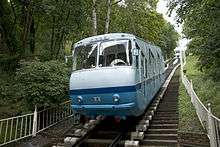Podil
Podil (Ukrainian: Поділ) is a historic neighborhood in Kiev, the capital of Ukraine. It is one of the oldest neighborhoods of Kiev, and the birthplace of the city's trade, commerce and industry. It contains many architectural and historical landmarks, and new archaeological sites are still being revealed. It is a part of the city's larger administrative Podilskyi District.
History

The name “Podil” means something that is situated downwards. This area used to be the trading and crafting center of Kiev. The names of some Podil neighborhoods reflect this fact: "Dehtyari" (those who works with tar), "Honchari" (potters), "Kozhemyaki" (craftsmen working with leather). On the territory of Podil were found ancient constructions, some of them date back to 9th–11th century. Intensive building within Podil took place in the 17th century. An annual fair was conducted since 1797.
Before the Great Podil fire of 1811 it was the most populous neighborhood of the city with 2,068 houses out of 3,672 dwellings in all of Kiev. The fire damaged the neighborhood extensively and changed the appearance of Podil dramatically. After the fire Podil was newly planned and a large number of new streets appeared, which still exist today. At this time were constructed such buildings as Contract's House, the National University of Kyiv-Mohyla Academy, shopping arcade and others.
Until World War II, the section just north of Nyzhniy Val street was called Ploska chast or Ploskaya sloboda. It was home to many poor Jews who lived there in wretched conditions.[1][2][3]
Attractions
Numerous attractions of Podil particularly include:
- Frolivsky Convent
- National University of Kyiv-Mohyla Academy
- House of Ivan Mazepa
- House of Peter the Great
- Fountain of Samson
- Zamkova Hora hill.
- Gostynnyi Dvir
Transport

Podil is connected to the city's metro system by the following three stations on the Kurenivsko-Chervonoarmiyska Line: Tarasa Shevchenka, Kontraktova Ploshcha (named after the Kontraktova Square) and Poshtova Ploshcha (named after the Poshtova Square).
The Kiev Funicular serves passenger traffic between Podil and the city's historic Uppertown neighborhood, today it is mostly used by tourists. Some time ago, the Kiev River Port served passenger traffic on the Dnipro River, but only tourists pleasure boats are available there nowadays.
Streets and squares
References
- ↑ Instituta Yudaiki Ukrainy, Yehupets, Vol. 4 (1998), p. 265: "Плоская часть — один из полицейских участков Киева (между ул. Нижний Вал и Куренёвкой, теперь Подольский район), в котором допускалось проживание евреев, временно находившихся в Киеве."
- ↑ Vladimir Meshchersky, Очерки нынѣшней общественной жизни в Россіи, Vol. 2 (Тип. Министерства внутренних дѣл, 1870), p. 38.
- ↑ A. Anatoli, Babi Yar (New York: Pocket Book, 1971), p. 70: "What a place that Podol was! It was the most poverty-stricken part of Kiev... Here from time immemorial had lived the poor of the Jewish community, the poorest of the poor..."
- Malikenaite, Ruta (2003). Touring Kyiv. Baltia Druk. pp. 146–147. ISBN 966-96041-3-3.
External links
| Wikimedia Commons has media related to Podil. |
- podilr.gov.ua - Administration website of the Podilskyi District (Ukrainian)
- Поділ in Wiki-Encyclopedia Kiev (Ukrainian)
- klymenko.data-tec.net - Photo gallery and information about Podil and its attractions (Ukrainian)
- Historical photos of Podil (Russian)